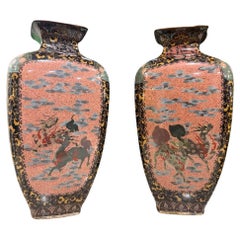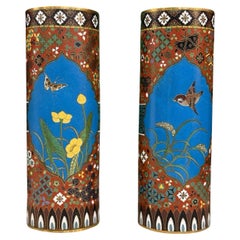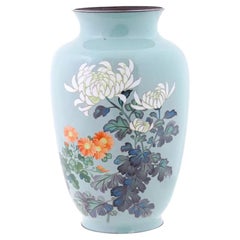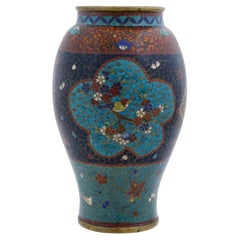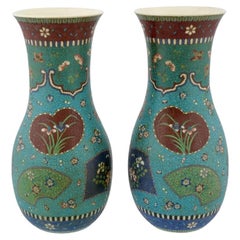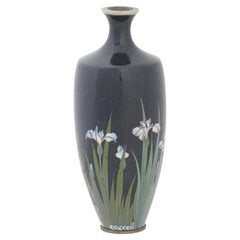Cloissoné Vases
Late 19th Century Japanese Meiji Antique Cloissoné Vases
Enamel
Late 19th Century Japanese Meiji Antique Cloissoné Vases
Enamel
Late 19th Century Japanese Meiji Antique Cloissoné Vases
Enamel
Late 19th Century Japanese Meiji Antique Cloissoné Vases
Enamel
20th Century Japanese Ming Cloissoné Vases
Porcelain
Late 19th Century Japanese Meiji Antique Cloissoné Vases
Enamel
Early 20th Century Japanese Cloissoné Vases
Enamel
Late 19th Century Chinese Antique Cloissoné Vases
Enamel
Early 20th Century Japanese Cloissoné Vases
Enamel
20th Century Japanese Meiji Cloissoné Vases
Enamel, Metal
20th Century Japanese Arts and Crafts Cloissoné Vases
Brass, Enamel
Early 20th Century Chinese Cloissoné Vases
Brass
20th Century Chinese Cloissoné Vases
Brass, Enamel
Early 20th Century Japanese Meiji Cloissoné Vases
Copper, Enamel
Late 19th Century Japanese Meiji Antique Cloissoné Vases
Enamel, Copper
Late 19th Century Japanese Meiji Antique Cloissoné Vases
Copper, Enamel
19th Century Japanese Meiji Antique Cloissoné Vases
Brass, Enamel
19th Century Japanese Antique Cloissoné Vases
Enamel
Late 19th Century Japanese Meiji Antique Cloissoné Vases
Enamel, Copper
Late 19th Century Japanese Meiji Antique Cloissoné Vases
Enamel
Late 19th Century Japanese Meiji Antique Cloissoné Vases
Enamel, Copper
19th Century Japanese Meiji Antique Cloissoné Vases
Enamel
19th Century Japanese Meiji Antique Cloissoné Vases
Copper, Enamel
Late 19th Century Japanese Meiji Antique Cloissoné Vases
Enamel
20th Century Japanese Cloissoné Vases
Metal, Enamel
Late 19th Century Japanese Antique Cloissoné Vases
Ormolu, Enamel
19th Century Japanese Meiji Antique Cloissoné Vases
Copper, Enamel
19th Century Japanese Meiji Antique Cloissoné Vases
Copper, Enamel
20th Century Chinese Cloissoné Vases
Brass, Enamel
Late 19th Century Japanese Antique Cloissoné Vases
Porcelain
19th Century Japanese Antique Cloissoné Vases
Bronze
20th Century Japanese Meiji Cloissoné Vases
Metal, Enamel
Late 20th Century Chinese Egyptian Revival Cloissoné Vases
Copper, Enamel
Early 20th Century Japanese Meiji Cloissoné Vases
Enamel
Early 20th Century Japanese Meiji Cloissoné Vases
Enamel, Brass
Late 19th Century Japanese Meiji Antique Cloissoné Vases
Enamel, Brass
Late 19th Century Japanese Anglo-Japanese Antique Cloissoné Vases
Bronze, Enamel
Early 20th Century Japanese Meiji Cloissoné Vases
Enamel
Late 19th Century Chinese Antique Cloissoné Vases
Enamel
19th Century Japanese Meiji Antique Cloissoné Vases
Enamel
Late 19th Century Japanese Meiji Antique Cloissoné Vases
Enamel
Early 20th Century Japanese Meiji Cloissoné Vases
Enamel, Silver
Mid-20th Century Japanese Mid-Century Modern Cloissoné Vases
Metal
19th Century Japanese Meiji Antique Cloissoné Vases
Enamel
20th Century Japanese Meiji Cloissoné Vases
Metal, Enamel
19th Century Japanese Meiji Antique Cloissoné Vases
Copper, Enamel
Early 1900s Japanese Art Nouveau Antique Cloissoné Vases
Copper, Enamel, Foil, Wire
20th Century Chinese Chinese Export Cloissoné Vases
Brass, Copper
Late 19th Century Japanese Meiji Antique Cloissoné Vases
Enamel
Early 20th Century Chinese Chinese Export Cloissoné Vases
Metal, Copper
Late 19th Century Japanese Meiji Antique Cloissoné Vases
Enamel
20th Century Chinese Chinese Export Cloissoné Vases
Brass, Enamel
1890s Japanese Meiji Antique Cloissoné Vases
Silver, Bronze, Enamel
Early 20th Century Japanese Meiji Cloissoné Vases
Copper, Enamel
1920s Chinese Vintage Cloissoné Vases
Brass, Enamel
Mid-20th Century Chinese Cloissoné Vases
Brass, Enamel
Late 19th Century Japanese Meiji Antique Cloissoné Vases
Copper, Enamel
19th Century Japanese Meiji Antique Cloissoné Vases
Enamel
19th Century French Antique Cloissoné Vases
Ormolu, Bronze, Enamel
Early 20th Century Japanese Meiji Cloissoné Vases
Brass, Enamel
Find Exquisite Antique Cloisonné Vases for Sale on 1stDibs
As ceramic vases and other types of decorative vessels are gaining popularity again — the personalization of handmade craftsmanship has served as a sort of anti-Internet to screen-weary designers — antique cloissonné vases can help introduce interesting colors and patterns to your space.
Technically, enamel is colored glass fused to metal. But that simple description greatly understates the case. Applied using an array of techniques to a wide range of objects, enamel is one of the most dynamic, and alluring, mediums in the world. And cloisonné vases, bowls, lamps and other objects and vessels ornamented with lustrous enamel can truly liven your home.
No one knows for sure when or where enameling originated. But, according to the Encyclopedia Britannica, it is widely believed that the decoration on a gold scepter found in a royal Mycenaean tomb at Kourion Kaloriziki, in Cyprus, and dating to the 11th century BC, is a true, early example of the technique.
Between the 6th and 12th centuries AD, cloisonné — in which tiny compartments (cloisons) made by soldering copper filaments to a metal surface are filled with vibrantly hued enamel — had a huge vogue in the Byzantine Empire. By the 7th century, Lombard craftsmen in northern Italy were using enamel to emulate Byzantine objects. In the 12th and 13th centuries, artisans in China imported the technique and made it so much their own that enameled objects have long been associated with Eastern aesthetics and motifs rather than Western ones.
Collectors of authentic antique Chinese furniture and decorative objects know that Ming dynasty-era cloisonné objects are particularly coveted. Although ornamentation was minimal at the time, Ming dynasty furniture often featured carved or painted details of flowers, insects, dragons, fruits and other motifs. As overseas trade expanded, techniques from the West, like cloisonné enamel painting, adorned table screens and other pieces.
Elaborately decorated Ming-era cloisonné objects and furnishings — vessels and other items featuring lots of vibrant colors and details — are likely to fetch considerable sums at auction, as Chinese cloisonné vases created during the Ming and Qing eras represent a golden age of the country’s furniture design. (Victorian cloisonné is also popular with design enthusiasts.)
Cloisonné wasn’t adopted in Japan until the 1800s. Back then, amid an era of societal and cultural shifts, a bolstered interest in art and design elevated Japanese craft traditions during the Meiji period. European styles like Japonisme appropriated Japanese design while craftsmen in places like Wales and England employed japanning, a varnishing technique that approximated the appearance of lacquer for the surfaces of furnishings.
Today, Meiji-era cloisonné vases or incense burners in good condition are of great interest to collectors of Asian art and furniture produced by the period’s Japanese cloisonné workshops.
Find antique cloisonné vases and other cloisonné objects for sale on 1stDibs.
